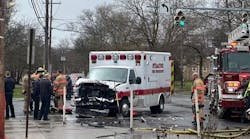Below are several accounts of what occurred during a fire in a single-family dwelling. One personal account is from Erin Craven, a part-time firefighter/EMT who completed firefighter training within the past year. This was her first interior fire. She lives at this house with her parents and was at home at the time of the fire. Another personal account is from Lieutenant Marty Stallings, a long-time friend of the family involved.
Colleton County, SC, Fire-Rescue is a combination fire-rescue department. This single fire district was created by an act of the County Council several years ago, combining 16 independent, community-based volunteer fire districts. The department has 325 members operating out of 28 stations with 72 full-time paid and part-time paid firefighters and the balance being volunteer firefighters. They protect 1,054 square miles with 82 vehicles.
Three Colleton County firefighters narrowly escaped injury at this incident. As you will read, Stallings reported that he heard the water from the exterior hoseline hit the wall in the fire room just prior to the actual backdraft explosion. As well stated by the fire-rescue director, Chief Barry McRoy, like most fire officers, “we preach constantly to never conduct an exterior and interior attack at the same time, but then it happens” and in this case, could have caused a tragic outcome.
Our sincere thanks to the officers and members of Colleton County Fire-Rescue and especially Firefighter-EMT Erin Craven, Lieutenant Marty Stallings and Chief Barry McRoy for their willingness to share their experience and lessons learned. We also appreciate the assistance of Grant Mishoe, editor of the website www.SConFire.com, for his support and details provided for this column.
The following is an account from www.SConFIRE.Com by Chief Barry McRoy:
At 9:15 A.M., firefighters were dispatched to a report of smoke coming from under the residence and in the air ducts at 8756 Bennett’s Point Road. The residence is located in a remote area about nine miles from the closest fire station. It took Engine 601, with one firefighter, 10 minutes to arrive on scene, with several firefighters arriving on the scene in their personal vehicles. The first-alarm assignment called for four stations to respond, and they were alerted. The total first alarm turned out two engines and four tankers with a total of 21 firefighters arriving within 20 minutes. Additionally, one EMS unit and three fire command officers also turned out. Due to daytime response, two additional engines that were due did not turn out.
Firefighters found heavy smoke conditions at the rear of the 100-year-old, two-story residence. The initial three-member attack crew made entry through the back door and advanced a 1¾-inch handline to the interior B side of the building. The door to the involved bedroom was closed. Upon reaching the hallway, firefighters noticed smoke bellowing from under the bedroom door, extending about three feet into the hall and then being sucked back in. Lieutenant Marty Stallings radioed for the building to be ventilated.
Within seconds, the fire burned through the door and we experienced a backdraft. This happened within seconds of an exterior firefighter, without command orders to do so, charging a hoseline and hitting the fire on the number-one floor from the outside just seconds before the explosion.
As the chief, with 30 years in the fire service, I have never experienced anything like this – I thought it was a propane tank, or something like it, that had exploded! The sound of the explosion sent our exterior personnel ducking for cover as glass, debris and fire were propelled throughout the yard with fire extending 30 feet out!
The interior crew was enveloped in fire, but amazingly stood their ground with the 1¾-inch line flowing to protect them. The second attack team advanced another 1¾-inch line to the second story. All upstairs windows were blown out. The sides of the building were displaced several inches with the roof being lifted about one to three inches from the rafters. With the building now well ventilated, firefighters made an aggressive attack on what was left of the fire, as the explosion reduced the conditions. Within 10 minutes, the bulk of the fire was under control.
Crews spent about 40 minutes performing overhaul and extinguishing hot spots. Only two rooms (one upstairs and one downstairs) and the attic suffered heavy fire damage. Most of the family’s personal belongings were saved and the lower floors and two rooms upstairs suffered only smoke, water and light heat damage. The building’s structural integrity was severely compromised.
Investigators interviewed the family members who were home at the time of the fire. The cause has been determined to be an electrical short in wiring to the heating unit. Contract workers had cut down a tree in the front yard of the residence, which fell on the power line supplying the home. The downed power line also started a half-acre woods fire.
The following account is by Firefighter/EMT (and occupant) Erin Craven:
When the lights went off due to the tree falling on the power line, I heard a “sparking” noise. I got up to see where the noise was coming from. Behind the computer and behind the refrigerator I saw sparking. Once my father came up the back steps, I told him to turn off the breaker box because the refrigerator was sparking. When I turned around and faced the back hallway, all I could see was thick, dark-gray smoke.
I grabbed the fire extinguisher and went into my parents’ bedroom. I then saw flames coming out of the air conditioning vent that is directly in front of the air conditioning unit. I shot the fire extinguisher into the vent, because they thought that maybe the fire was just in the air conditioning unit. I left their room, grabbed some important things and left the house to call the fire department.
We moved the cars away from the house and I put on my bunker gear. My father and some other men then opened manholes and dark-gray smoke came billowing out from under the house. They tried to put out the fire with extinguishers and water, but the fire had gotten too far. It was the worst feeling in the world to stand there, with my gear on, and watch flames in my parents’ bedroom through the window, knowing that I couldn’t do anything until the fire trucks arrived. While waiting for the fire trucks, I could see only a small amount of smoke seeping from the window panes in my parents’ bedroom.
Once the first engine and tanker arrived, I put on an airpack and went inside the house with my partner. We crouched down and went through the kitchen, living room and hallway. We went too far and were in the bathroom before we knew it. We backed up and he asked me where the door was to my parents’ bedroom. I felt around and found the corners of the door frame, and tapped the door harder, enough that it cracked open. I noticed that when I tapped on it that there was a great deal of force pushing it back toward us. When the door cracked, extremely hot air came out of the room and we could feel it through our gear. We then noticed the puffing out and sucking back in of the smoke under the door. My partner and I got out of the house.
I sat outside and did not go back in. Smoke was coming out of the cracks between the wood. It had a slight yellow tint; it was no longer gray or black. Firefighters broke a window to my parents’ bedroom and flames came rushing out of the window, shooting as high as 10 feet or more. Once that was done, a second team made entry and, upon them reaching the bedroom, a loud explosion was heard. Flames shot out of the other two windows from my parents’ bedroom and blew the glass approximately 20 feet from the house.
Once they knocked the fire down, they realized that when the explosion occurred, fire had entered an upstairs bedroom. Firefighters were then sent up there to extinguish the fire. The explosion lifted the roof off the house. Windowsills upstairs were pushed away from the house and sticking out at least a foot. The windows and light bulbs upstairs had a yellow-gray look to them after the fire, from the smoke.
The following account is by Lieutenant Marty Stallings:
The call was dispatched as a structure fire on Bennett’s Point Road with fire under the building. I was familiar with the structure and knew it was an older two-story home with balloon construction and all wood. When I arrived on scene, light smoke was showing from the exterior. I saw the initial-attack crew exiting the building. The firefighters reported they did not find any fire, but that the door to the room involved would not open.
I looked inside the door and could see heavy smoke developing rapidly. I donned my gear and made entry, coming in behind Firefighters Austin Williams and Shane Rushton. They were at the door of the bedroom at the B-C corner of the building on the first floor. I went to the door and found smoke puffing from under and up the sides of the door about three feet into the hallway. I called for a ventilation fan to be set up at our point of entry and for the windows in the room to be ventilated.
We were in the hallway waiting for the exterior crew to set up ventilation. I could hear the windows break, but the fan was not running, and I was going to wait until it was running before opening the door. While waiting for the fan, I heard an exterior water stream flowing into the room. Immediately, fire blew out the top of the bedroom door and down the hall over us. We all got as low to the floor as we could. I didn’t hear the explosion, but could feel the pressure coming from it and knew it was possibly a backdraft. All crew members were OK, thankfully. We entered the room and extinguished the fire.
Fire conditions in the room were not extremely heavy at this point. We could tell the fire was in the second story and another line was brought in. Fire heavily damaged the first-floor room and the room above it on the second floor. Extensive salvage and overhaul operations took place and were able to save a lot of personal belongings. The rooms adjacent to the involved rooms had no fire damage, but they did have smoke damage. The floors and ceiling were tongue-and-groove hardwood with the walls consisted of a combination of hardwood and sheetrock. During overhaul, we found the structural damage to the roof and walls from the explosion.
The explosion took out about two feet from the top of the door, the same door we sat by awaiting ventilation. This fire was a great tragedy to the family, but a great learning experience for everyone. The members of the family occupying the house are long-time friends and their oldest daughter is a part-time firefighter/EMT with our organization who made her first entry on this fire call.
These comments are based on Chief Goldfeder’s observations and communications with the writers and others regarding this incident:
Responding to a dwelling fire may be considered “routine” by some, but as we know, no response should ever be comfortably treated as “routine” – and for good reason. In this case, the fact that this was a firefighter’s home was of some interest due to the emotional “tie” that was created. Not only did the firefighter discover it, but she reported it, attempted to fight it until the arrival of the fire department and then became a part of the interior crew – a clear example of multi-tasking!
Rural firefighting creates several serious challenges that are often foreign to firefighters in suburban and urban areas. On the other hand, many of the tasks that must be performed at a single-family dwelling fire in a big city must still be performed at the rural single-family dwelling fire as well. Issues such as command staffing, firefighter staffing, resources, time and distance can stress any organization to its limits. In a rural setting, they can be even more challenging.
In this case, they were ALL factors. The house is nine miles from the nearest firehouse. The command staff had to respond 22 miles to this incident and staffing was thin. This is not an unusual situation for this fire department and many others in rural settings. These are “knowns” and therefore must be counted on and planned for. Fire departments, be they volunteer, part time or full time, must always plan for the “knowns” before a predictable situation occurs. Staffing on many fire departments is a challenge but must be dealt with. The fact is that it takes trained firefighters to perform the required tasks at a fire and there are few options in facing the staffing issues no matter what kind of fire department you have. Colleton County Fire-Rescue has made great strides in improving its levels of service over the last several years and it continues to move in a positive direction.
At this fire, one factor that contributed to the firefighters’ problems was that a 1¾-inch line was charged and used to hit the fire from the exterior .with firefighters still operating interior. As each of the writers indicated, it should not have happened and it was not directed to happen.
All of us have been on fire scenes where situations have occurred or actions were taken that were not directed by command. In most cases, nothing terrible occurs as a result of those actions. But, on occasion, the results can be far more tragic than what occurred at this fire. The problem is that the more we allow tactics to occur “the wrong way,” we become comfortable with it and they then become the norm.
What is the solution? As in almost all of our close calls, training is the solution – training on such critical factors such as fire tactics, operational discipline, command, control, communications, operating procedures and accountability. Of course, “accountability” means knowing where members are and are operating, but it also mean all members understanding that they must be accountable for their actions and must understand the consequences of their actions if fireground rules aren’t followed. Rarely do firefighters do something intentionally to hurt or interfere with an operation; their intentions are pure, their interest is to help. But if that “help” is the result of poor training, lack of knowledge or not directed or led by an incident commander or sector officer (or they haven’t arrived yet), the results can create very negative consequences. And when an incident commander or boss cannot be there to provide that leadership or direction, all of the members’ fire training must kick in so they can understand the outcome of their actions. How does that happen? Again, the only answer is training. Is it easy to get this done? Not at all. But if you are looking for easy, consider riding a flower-delivery truck and not a fire truck.
Another tactic that requires training as well as strict coordination through command is the use of positive-pressure ventilation (PPV) fans. Yes, these fans are a great tool as a part of the incident commander’s “arsenal” to get the incident under control. However, incident commanders, officers and firefighters alike must use extreme caution when placing and activating the fans so the use of the fans doesn’t make conditions worse. In this fire, that was not a factor. However, there have been fires where the improper use of PPV directly resulted in tragic outcomes. PPV, like a hose stream, axe, power saw or thermal imager, is a tool to be used on the fireground by trained firefighters under the command of experienced and trained fire officers.
When training is missing, problems are predictable. When training occurs, at all levels, the positive results as well, are predictable, and once again, everyone goes home!
William Goldfeder will present “Firefighter Close Calls: Injury & Death Prevention” at Firehouse Expo 2005, July 26-31 in Baltimore.William Goldfeder, EFO, a Firehouse® contributing editor, is a 32-year veteran of the fire service. He is a deputy chief with the Loveland-Symmes Fire Department in Ohio, an ISO Class 2 and CAAS-accredited department. Goldfeder has been a chief officer since 1982, has served on numerous IAFC and NFPA committees, and is a past commissioner with the Commission on Fire Accreditation International. He is a graduate of the Executive Fire Officer Program at the National Fire Academy and is an active writer, speaker and instructor on fire service operational issues. Goldfeder and Gordon Graham host the free and noncommercial firefighter safety and survival website www.FirefighterCloseCalls.com. Goldfeder may be contacted at [email protected].




